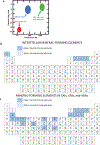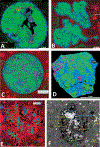An evolutionary system of mineralogy. Part II: Interstellar and solar nebula primary condensation mineralogy (>4.565 Ga)
- PMID: 33958805
- PMCID: PMC8098038
- DOI: 10.2138/am-2020-7447
An evolutionary system of mineralogy. Part II: Interstellar and solar nebula primary condensation mineralogy (>4.565 Ga)
Abstract
The evolutionary system of mineralogy relies on varied physical and chemical attributes, including trace elements, isotopes, solid and fluid inclusions, and other information-rich characteristics, to understand processes of mineral formation and to place natural condensed phases in the deep-time context of planetary evolution. Part I of this system reviewed the earliest refractory phases that condense at T > 1000 K within the turbulent expanding and cooling atmospheres of highly evolved stars. Part II considers the subsequent formation of primary crystalline and amorphous phases by condensation in three distinct mineral-forming environments, each of which increased mineralogical diversity and distribution prior to the accretion of planetesimals >4.5 billion years ago.
Interstellar molecular solids: (1)Varied crystalline and amorphous molecular solids containing primarily H, C, O, and N are observed to condense in cold, dense molecular clouds in the interstellar medium (10 < T < 20 K; P < 10-13 atm). With the possible exception of some nanoscale organic condensates preserved in carbonaceous meteorites, the existence of these phases is documented primarily by telescopic observations of absorption and emission spectra of interstellar molecules in radio, microwave, or infrared wavelengths.
Nebular and circumstellar ice: (2)Evidence from infrared observations and laboratory experiments suggest that cubic H2O ("cubic ice") condenses as thin crystalline mantles on oxide and silicate dust grains in cool, distant nebular and circumstellar regions where T ~100 K.
Primary condensed phases of the inner solar nebula: (3)The earliest phase of nebular mineralogy saw the formation of primary refractory minerals that solidified through high-temperature condensation (1100 < T < 1800 K; 10-6 < P < 10-2 atm) in the solar nebula more than 4.565 billion years ago. These earliest mineral phases originating in our solar system formed prior to the accretion of planetesimals and are preserved in calcium-aluminum-rich inclusions, ultra-refractory inclusions, and amoeboid olivine aggregates.
Keywords: Classification; chondrite meteorites; condensation; interstellar mineralogy; mineral evolution; natural kinds; nebular mineralogy; vapor deposition.
Figures




Similar articles
-
An evolutionary system of mineralogy. Part III: Primary chondrule mineralogy (4566 to 4561 Ma).Am Mineral. 2021 Mar;106(3):325-350. doi: 10.2138/am-2020-7564. Epub 2021 Mar 1. Am Mineral. 2021. PMID: 33867542 Free PMC article.
-
An evolutionary system of mineralogy. Part I: Stellar mineralogy (>13 to 4.6 Ga).Am Mineral. 2020 Apr 29;105(5):627-651. doi: 10.2138/am-2020-7173. Am Mineral. 2020. PMID: 33867541 Free PMC article.
-
Formation and processing of organics in the early solar system.Space Sci Rev. 1999;90(1-2):275-88. doi: 10.1007/978-94-011-4211-3_25. Space Sci Rev. 1999. PMID: 11543289 Review.
-
Multiple generations of grain aggregation in different environments preceded solar system body formation.Proc Natl Acad Sci U S A. 2018 Jun 26;115(26):6608-6613. doi: 10.1073/pnas.1720167115. Epub 2018 Jun 11. Proc Natl Acad Sci U S A. 2018. PMID: 29891720 Free PMC article.
-
Detection of organic matter in interstellar grains.Orig Life Evol Biosph. 1997 Jun;27(1-3):53-78. Orig Life Evol Biosph. 1997. PMID: 9150567 Review.
Cited by
-
An evolutionary system of mineralogy. Part III: Primary chondrule mineralogy (4566 to 4561 Ma).Am Mineral. 2021 Mar;106(3):325-350. doi: 10.2138/am-2020-7564. Epub 2021 Mar 1. Am Mineral. 2021. PMID: 33867542 Free PMC article.
-
Open-ended versus bounded evolution: Mineral evolution as a case study.PNAS Nexus. 2024 Jun 25;3(7):pgae248. doi: 10.1093/pnasnexus/pgae248. eCollection 2024 Jul. PNAS Nexus. 2024. PMID: 39015545 Free PMC article.
-
Historical natural kinds and mineralogy: Systematizing contingency in the context of necessity.Proc Natl Acad Sci U S A. 2021 Jan 5;118(1):e2015370118. doi: 10.1073/pnas.2015370118. Proc Natl Acad Sci U S A. 2021. PMID: 33361151 Free PMC article.
References
-
- Abe T, Tsukamoto K, and Sunagawa I (1991) Nucleation, growth and stability of CaAl2Si2O8 polymorphs. Physics and Chemistry of Minerals, 17, 257–281.
-
- Affiatalab F, and Wasson JT (1980) Composition of the metal phases in ordinary chondrites: Implications regarding classification and metamorphism. Geochimica et Cosmochimica Acta, 44, 431–446.
-
- Aléon J, Krot AN, and McKeegan KD (2002) Calcium–aluminum-rich inclusions and amoeboid olivine aggregates from the CR carbonaceous chondrites. Meteoritics & Planetary Science, 37, 1729–1755.
-
- Alexander CMO’D, Fogel M, Yabuta H, and Cody GD (2007) The origin and evolution of chondrites recorded in the elemental and isotopic compositions of their macromolecular organic matter. Geochimica et Cosmochimica Acta, 71, 4380–4403.
Grants and funding
LinkOut - more resources
Full Text Sources
Research Materials
Miscellaneous
